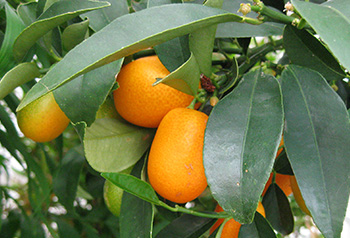Kumquat

Kumquat is a small evergreen tree that makes an excellent ornamental and rewards the grower with its tiny, tangy fruits. Kumquats are the smallest citrus fruits and are affectionately known as “the little gold gems of the citrus family.” The kumquat genus, Fortunella, is named after Robert Fortune, who introduced kumquats to Europeans. The word “kumquat” combines the Chinese words gam (meaning gold) and gwat (meaning tangerine).
Characteristics

Kumquat fruits have a thin, sweet peel and tart flesh. They look like small, ovate oranges and tend to be less than two inches long. You can eat kumquats just like you’d eat grapes; there’s no need to peel them! It’s the only citrus fruit you can eat “skin and all.” The kumquat tastes best when gently rolled between the fingers before being eaten to release the flavors. Kumquats are a unique addition to many recipes, and are a favorite for jelly, marmalade, and chutney.
The tree grows to a maximum height of 15 feet, which makes it suitable for planting as a shrub, specimen tree, or in a large container. Plants appear similar to most citrus trees, with spear-shaped leaves and small white flowers, but on a smaller scale.
Several varieties are available, including the sweeter and less-seedy ‘Meiwa’ and sourer ‘Nagami’. There are also options that strike visual interest with variegated leaves and fruits, such as ‘Centennial’. The trees are cold hardy to 10°F, meaning cold damage is not a concern in Florida.
Planting and Care
For the most plentiful harvest, plant your kumquat tree in a sunny location, although it will grow in partial shade. Luckily, kumquat is self-pollinating, meaning it will produce fruit even if you only plant one tree. If you decide to plant multiple trees, make sure they are far enough apart that they will not shade the lower branches of neighboring trees at maturity.
Container-grown trees are best for planting, and they can be established any time during the year. Remove the tree from its pot and brush away some of the soil from the root mass to encourage root growth. Remove any broken or crisscrossing roots as well. Then, plant the tree so the root ball (or the base of the tree) is level with the soil line. Make sure the uppermost root is above ground (approximately 10% of the root ball).
An easy way to estimate the hole depth is to measure from the top of the root ball to the bottom of the root ball, then subtract an inch or so. Dig the hole at least one and a half times the diameter of the root ball to break up the soil around the tree. Once the root ball is set in the hole, backfill with soil while taking care to not compact it. No soil amendments are necessary because adding potting soil or the like can make the roots “girdle” or grow in a circle and eventually strangle the trunk. Using only native soil causes the roots to adventure from the planting site to look for nutrients.
Thoroughly watering your new tree is important for establishment. To ensure that your irrigation doesn’t run off, apply mulch around the base of the tree. The mulch should be two to three inches deep and a foot away from the base of the tree. If you have a hose available, use it to run water into the berm for 10 to 15 minutes twice per week (filling the basin) for the first month. This equates to about eight to 10 gallons per watering. Irrigation is less crucial after the first month, but water should still be supplied if new growth is wilting by the afternoon.

Start thinking about fertilization three weeks after planting, or when new growth is beginning. A citrus-formulated fertilizer product should be applied following the label directions every six weeks from February through October for the first year. Make sure the fertilizer covers the entire soil surface above the root ball.
Weed management primarily consists of keeping the soil cleared under the tree canopy. This is important because plants touching the trunk of the tree could transmit a fungus called foot rot. Most pests are controlled by natural predators, but gentle control can be applied if an issue arises. Contact your county Extension office for pest identification and management information.
As your tree develops, check it regularly to see if there are any shoots from the base. These are called “suckers” and need to be removed because they will not produce good fruit and waste the tree’s resources. The canopy should not be pruned unless absolutely necessary (and even then, sparingly) because it will harm fruit production. When pruning, make sure to follow the UF/IFAS guidelines.
Fruits will reach maturity by October and the tree will continue to produce through March. Unlike other more finicky citrus varieties, kumquat is easy to manage once established and will produce many golden fruits if given the proper care.
Whether you’re an established kumquat lover or are new to the fruit, you can also check out the Annual Kumquat Festival® in Dade City! This is an opportunity to try the many ways kumquat is prepared. The January festival is located right next to St. Joseph, which is the Kumquat Capital of the World.
